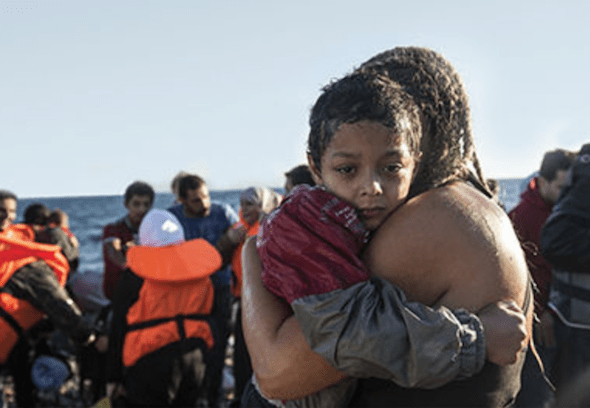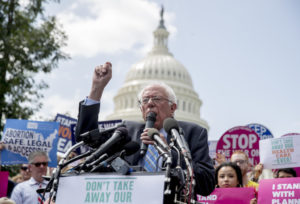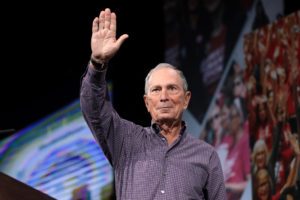‘Informed Rant’: The Violence of Borders, Racist Mascots and The Real News
In this week’s episode of Joshua Scheer's podcast, Scheer speaks with Reece Jones, associate professor of geography at the University of Hawaii, Manoa, about Jones’ book, “Violent Borders: Refugees and the Right to Move."
Detail from the cover of Reece Jones’ book, “Violent Borders.” (Verso Books)
In this week’s episode of “Informed Rant,” the podcast of Joshua Scheer, Scheer speaks with Reece Jones, associate professor of geography at the University of Hawaii, Manoa, about Jones’ book, “Violent Borders: Refugees and the Right to Move” and the human cost of borders.
Scheer also speaks with Paul Jay, co-founder and editor in chief of The Real News, about the site’s significance, and Robert Holden, deputy director of the National Congress of American Indians, about racism and sports mascots after the World Series.
A rushed transcript of Scheer’s exchange with Jones follows.
—Posted by Alexander Reed Kelly
Joshua Scheer: My guest right now is Professor Reece Jones, he’s a geopolitical expert. He teaches geography at the University of Hawaii Manila. His book is “Violent Borders”. We’re discussing refugees. Thank you for joining me.
Reece Jones: Thanks for having me on.
Scheer: You ask this question in the book, and obviously every day there’s some big story about migrants and refugees and what’s happening in the world. We just saw it yesterday with the so-called jungle being torn down in France. This morning I woke up to the BBC saying 238 migrants may have drowned outside of Libya. You study this, talking about limiting the movements of the poor and you ask this question in the beginning of your book. Talk about this. The limiting of the movements of these refugees and what you’ve seen, both in your field research, but also in the media reports and everything else that we’re all seeing right now. We’ve seen over the last, certainly the last few years, but this is not a new movement as you write about in your book.
Jones: I’ve been studying borders for about 15 years now, and over that period of time, I’ve seen two big changes happening at borders. The first is the construction of a lot of border infrastructure that is designed to limit the movement of people across border spaces and to deter people from trying to make trips across borders. This infrastructure is both the deployment of a lot more border agents at borders, the use of new surveillance technologies and military technologies in border spaces, but it’s probably most evident if you look at walls.
Walls are a good way to symbolize the hardening of borders that’s happened in the past 15 years. In 1990 there were about 15 border walls around the world, so relatively few. Today there are almost 70 walls on borders around the world, so there’s been a dramatic increase in the number of walls. Those walls symbolize all of the other infrastructure that goes along with that. The militarization of the security in these spaces.
The second trend that I’ve noticed that goes along with that is a dramatic increase in the number of people dying at borders. If you look at the edges of the European Union, in the 1990s there were less than a hundred deaths per year at the edges of the EU, whereas in the past decade, those numbers have gone up dramatically. We’re talking about in the last 3 years in a row, over 3,500 people have died at the edges of the EU every single year.
That’s part of a global trend. From 2005 to 2014, 40,000 people globally died trying to cross the border. In the last 2 years, as you mentioned during your introduction, that’s increased even more. Over 10,000 people have died trying to cross a border in just 2015 and 2016.
Scheer: Yes, and you have the number in … A lot of numbers in your book, and it’s very interesting walls. Can you explain, we’re going to get into the violence aspect, but explain this concept that was foreign to me, humanitarian fencing which you saw in Spain and elsewhere. What is humanitarian fencing? How does that relate?
Jones: In some border areas, there’s an effort to construct fencing that is meant to deter people from crossing rather than injure them in the crossing process. If you look at the US fence, the one that was built after the Secure Fence Act passed in 2006, it doesn’t have a lot of barbed wire on it, instead it’s a wall, it prevents movement, but it doesn’t have the ways to injure people crossing. The EU fencing in Spain for example, is also similar in that respect. It doesn’t have all the barbed wire that we see in other borders around the world.
That doesn’t mean that it doesn’t have a dangerous effect on people’s lives, because what we see over and over again is that as particular border crossing routes are closed, fences are always built in the easier places for people to cross between cities, it diverts people to ever more dangerous routes. That’s why there’s been this dramatic increase in deaths, because as borders become harder to cross, we’ve seen that it doesn’t deter people from crossing as it was predicted to do. Instead, it forces them to cross in these very dangerous places, which means the deserts of the US Southwest.
In Arizona for example, where the number of deaths increased dramatically as fences were built on the US border. At the edges of the EU it means the people are crossing in the Mediterranean. They’re having to go to Libya, and having to use smugglers and are put in these very dangerous situations, which results in these really high death rates of people trying to cross into Europe.
Scheer: My guest is Reece Jones, he’s a geography professor at the University of Hawaii Manila, and his book is Violent Borders, Refugees and the Right to Move. This is not a new concept as you write about though. The Great Wall of China you write about, Hadrian’s wall, it created a defensive control. Good taxes, and let’s get into that a little bit. The walls that were created, like for the Great Wall of China, and then with feudal lords and common lands using hedges and other mechanisms.
We start to shift the conversation into the state’s responsibility, because as you write in your book, this is not … One, as you write or as other geographers have also written, to be modern is to be … Modern citizen it to be a mobile citizen, and also we have been always in migration. Our history’s in migration. Let’s talk about the history of basically creating walls and then where we have reached today in which states are protecting us and we have this national identity based on borders.
Jones: What I argue in the book, the broader argument that I make in the book is that the walls that we see today and all of the security infrastructure that goes along with them at borders, the idea of citizenship, the use of passports, the imposition of border patrols, is new in the way that it’s happening at borders, but I argue that it’s part of a much longer term history that’s part of this contest between people moving around and states’ efforts to try to control that movement.
I argue that a powerful historical process is the state using movement restrictions to contain the poor to particular places to lower their wages to to make them have no wages. What we see today is part of that longer history. In the past it was things like slavery, or serfdom, or vagrancy laws or poor laws, that kept the poor locked into particular places and allowed the wealthy to access their wages to they work at low wages or no wages. Today we see that with borders.
The poor are restricted to the countries of their birth and this creates pools of low-wage labor that lets corporations move factories to locations where it’s advantageous to them, but doesn’t allow workers to move to places where they could demand higher wages. What I argue in the book is that the violence we see at borders today is part of that effort to contain the poor to particular places to protect the privileges and wealth that have accrued in other places.Scheer: I can actually use this as a real-life example. Heading down to Mexico with my wife, who is from [inaudible 00:07:24], and the number of people in her family were talking about this, trying to get to America because in Mexico one of her aunts is making $5 for 12 hours of hard work. Whereas the US minimum wage is much higher and certainly we saw this in the early part of the election before he educated Bernie Sanders. There was an issue about open borders in which he was very strongly stanced against them and it did cause some controversy early in his run.
This mobile citizen idea, how do we get past the idea? Is open borders the policy, and how do we get past this fear factor. Fear of terrorism, of lower wages, etc, etc. because people will come from Mexico and work for much cheaper and all these kind of myths and scare tactics that are often used. How do we get over that? Explain that, this mobile citizenry and what it might look like coming into the next generation.
Jones: The first thing that I want to emphasize is that a lot of the middle class and lower middle class in the United States feels very insecure from the last 30 or 40 years because the process of globalization, the moving of jobs to other places, opening borders for capital and for consumer goods, has not benefited them. Instead, they’ve seen the high wage and secure jobs that they had in a manufacturing plant say, in the 1960a or ’70s, moved elsewhere and been replaced by contingent jobs that don’t have good benefits and have lower wages. The anger that people feel towards this process of globalization is very real.
I would argue that it’s misplaced, that blaming migrants and blaming the idea of free movement misses the cause of this insecurity that people are feeling, because the problem has been that over this period of globalization, corporations and capital and goods can move freely across borders, but workers cannot. Regulators cannot either, and so it’s produced the situation where all of the benefits of globalization have gone to the elite and to corporations while workers on both ends of that relationship have seen their wages eroded and the protections of worker rights have been taken away in the US.
What I suggest is that the way to get around this is to open up borders for migration, to allow workers the freedom to move to wherever they want to, which would work over time to stabilize wages globally. There would be less incentive for corporations to move jobs elsewhere if workers weren’t contained to those places creating these pools of low-wage labor, but then it would allow workers in those places to come to places that had higher wages for them.
If you look at the data about the movement of people, there’s this fear that people migrating to the United States, lower wages for the poor in the United States, the data doesn’t support that. Instead, study after study shows that as more people migrate to the US, it has an overall benefit on the economy. One study showed that for each person that comes, they produce one 1.2 additional jobs in that community, and that’s because in addition to working their own job, they’re also going to the market, they’re taking the bus, and so they’re contributing to the economy of the society as well so that they bring benefits along with them.
Scheer: I want to let our listeners know we’re speaking with Reece Jones, he’s a geography professor at the University of Hawaii. The book we’re discussing is his book, and we’re also discussing obviously, news and current events because this is in the news almost daily, is Violent Borders, which is available from Verso everywhere. You write in your book about violence and the threats of violence. I think you have about 5 or 6 different kinds of violence. What I’m researching right now about 2 hours ago, the Intercept has a piece, Bulgaria welcomes refugees with attack dogs and beatings.
We’ve seen images of people, kids drowning, everything else. How is this violence working towards curtailing the situation, because that’s one of the … The threat of violence, the threat of trespassing and all these different levels of violence that you discuss in your piece, but actual violence, perceived violence, all these levels of violence. Is it working, or obviously there’s an intent to keep people out, but is it working?
Jones: That’s a complicated question I think. There are different types of violence at borders. The first is direct violence by border agents towards people on the move, so the story you referenced from Bulgaria is certainly an example of that. At the US/Mexico border 33 people have been killed by border patrol agents in the last 5 years. There’s also a structural violence to borders. It’s the role that the hardening of borders plays in funneling people to these more dangerous places to cross. The deaths in the Mediterranean I argue, are directly attributable to the construction of fences and walls, and the deployment of more border guards in easier to cross places at the edges of the EU.
That’s also a death produced by the border. The question of whether hardening borders works, is a complicated one. There’s no doubt that in places where fences are put up and these violent border guards are put in place, it does make it very difficult to cross there. You see that with Hungary last year. Two years ago, a lot of people were crossing the border into the EU via Hungary. Hungary built the fence, Hungary deployed a very aggressive border force there, and crossings into Hungary have gone to almost zero. That doesn’t mean that people aren’t crossing into the EU still, instead they’re now taking different routes to do it. That’s funneling people to go to Libya and cross through the Mediterranean.
The overall rate of people crossing borders isn’t affected often by these constructions of walls, but it does have a direct impact on the places where the walls and fences are actually constructed. That’s why the deaths tend to increase as these fences and walls are built.Scheer: What’s very interesting, I want to talk about Hungary exactly, because I was just reading a piece about this in Nation. Hungary obviously has said some terrible things. We had this on the show maybe a year ago, but Hungary wants to be part of the EU. To go to your point about mobile citizenry and as a modern citizenry, they want to be able to go get jobs in the EU, which they would be able to do as member states. It’s very hypocritical. They don’t want migrants into their country, but they want to have the right of migration.
Jones: Yes, and you see a similar sort of thing with the recent Brexit vote. In fact, within the European Union, the country that has the most citizens living outside of their country of origin is the United Kingdom, so there are more UK citizens living in other parts of Europe than any other country in terms of moving within Europe. Those people who do work in these other countries throughout Europe of course, they want to continue to be able to have that access. There is this double standard that you’re suggesting of wealthy people want to be able to move freely around the world, but they also simultaneously want to be able to limit other people from being able to do the same thing.
Scheer: It’s very interesting and then also recently I was reading 10 of the world’s poorest countries host half of the global refugee population. That’s another one that obviously is a problem. As you were discussing earlier about keeping wages down and everything else, we want to keep these people depressed, but this is not the way we should conduct ourselves in a global world, right?
Jones: You’re right about that. It’s Turkey, Lebanon, are 2 countries that have very high numbers of refugees. Lebanon for example, has I believe it’s about 150 refugees per every 1,000 people in Lebanon. For the EU to have a similar rate of refugees in the EU, that would be something like 100 million refugees arriving in the European Union rather than the may 1 to 2 million that arrived last year. The majority of the burden for caring for refugees and being the countries that receive refugees into them is borne by poorer countries, not by the US, EU, or Australia.
Scheer: I do recommend the book. I want to ask you one last question, because there’s no real way to wrap up. Obviously, these stories are in the news, we have to put pressure to open our borders and to allow some sort of migration and there’s a whole slew of problems that come with that, but we have to deal with those problems. The book again is … I’m talking to Reece Jones though, and the book is Violent Borders, How States Keep People Out. What’s the one or two things you want to leave listeners with going forward, that one thing that maybe they can do. As a citizenry what people can do, and then also what we should be on the lookout for within the next years.
Jones: In terms of thinking about the idea of a right to move, I think there’s short-term things that can be done to improve the situation of refugees right now. One of those is to pressure politicians, pressure congress to increase refugee quotas into the United States. This past year the US accepted 110,000 refugee resettlements. Hillary Clinton has said she’ll increase that to 550,000, which would be a step in the right direction. The UN reports that there are 65 million people globally displaced by conflict, so one of the big problems today is that the number of people who are being resettled doesn’t match the number of people who need resettlement. That’s a short-term thing that can address that.
I think in the longer term we need to start to resist the demonizing of people on the outside. It’s very easy to use this us/them rhetoric and that we need to protect us and protect our economy and protect our culture, and the way to do that is to keep them from coming in. I think that it’s important for us in our daily lives to recognize that people are people around the world and that we have a lot of things that we share and that movement should be one of those things, that movement should be a fundamental human right.
Scheer: I would also add I guess, as you were talking about this is to remember that this isn’t just a global store and a place for global wars. Those things have consequences and if you want to buy cheap goods, and you want to have foreign conflict, then these are the consequences, right?
Jones: Yes. The only way that for example, clothing is a cheap as it is today is because there are these people who are captured in countries through border restrictions, through the idea of citizenship, through passports that don’t allow them to move to other places to access better jobs, and so instead they have no other option but to work in a sweatshop-like factory to produce clothing for only a dollar or two a day, so that the profits from that can go to corporations and so that we as consumers in the United States can buy clothes for such low prices. There’s a cost to that.
Scheer: My guest is Reece Jones, he’s a geography professor at the University of Hawaii, Manoa, and his book is “Violent Borders, Refugees and the Right to Move.” I want to thank you for joining me.
Jones: Thanks for having me on.
Independent journalism is under threat and overshadowed by heavily funded mainstream media.
You can help level the playing field. Become a member.
Your tax-deductible contribution keeps us digging beneath the headlines to give you thought-provoking, investigative reporting and analysis that unearths what's really happening- without compromise.
Give today to support our courageous, independent journalists.






You need to be a supporter to comment.
There are currently no responses to this article.
Be the first to respond.